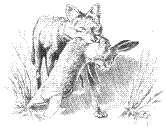Center, Internet, Wildlife Damage Management

Coyotes in the Southwest: A Compendium of Our Knowledge (Symposium Proceedings, 1995)
Date of this Version
January 1995
Document Type
Proceeding
Citation
Published in Coyotes in the Southwest: A Compendium of Our Knowledge, Symposium Proceedings, December 13–14, 1995, San Angelo, Texas
Edited by Dale Rollins, Calvin Richardson, Terry Blankenship, Kem Canon, and Scott Henke
Abstract
The development of the reproductive system and the dynamics of reproductive hormones were studied in captive male and female coyotes (Canis latrans). Captive male coyotes exhibited incomplete sexual maturation at the first reproductive season (< 12 months of age). Peak serum testosterone levels in 1-year old males were 50% (300 ± 200 vs. 810 ± 300 pg testosterone/ml) and total sperm production was only 10% (57.4 ± 6.6 vs. 558.8 ± 26 x 106 total sperm) of that observed in males older than 1 year. Yearling males were never observed copulating with a female. The sexual maturation of captive female coyotes was less equivocal than their male counterpart's. The pregnancy rate of yearling females was 40% compared to 63% m older females. Average peak serum LH values at the ovulatory surge were 33 ng/ml in yearling females compared to 60 ng/ml in older animals. Serum FSH, estradiol and progesterone levels were similar. There also appears to be an inhibition of fecundity in subordinate females, the mechanism for which IS currently unknown. Our long range goal IS to capitalize upon this information to develop methodologies for coyote population control.


Comments
Published 1996, Austin, Texas. Used by permission